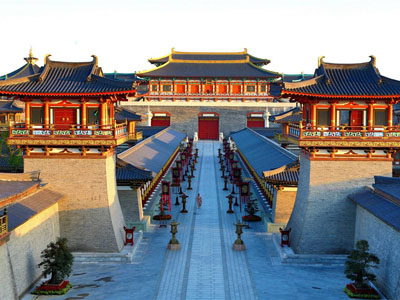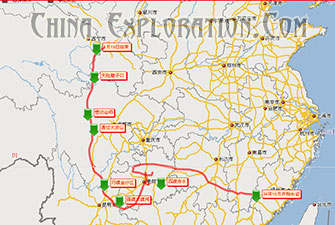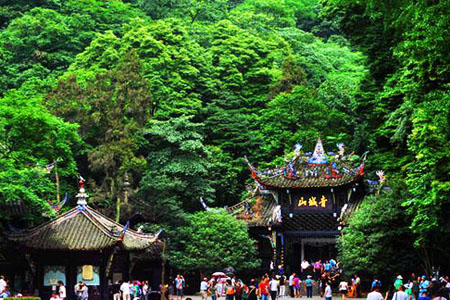It is overland tour to Mt. Wudangshan in Hubei province from Xian. Hubei province is located in mid China connecting many provinces in China by convenient transportation of railway, cruise, and flights......

The Long March saved Mao Zedong and the Communist Party from the attacks by the Guomingdang. The Long March came about when the Chinese Communists had to flee a concerted Guomingdang attacked that had been ordered by Chiang Kai-shek.
In the autumn of 1933, the Guomindang leader Chiang Kai-shek launched a huge attack against the Communists who were then based in the Jiangxi and Fujian provinces in south-east China. The Guomindang was advised by the German general, Hans von Seeckt. He advised Chiang Kai-shek not to launch a full frontal attack on Jiangxi. 500,000 Guomindang troops surrounded Jiangxi in an attempt to strangulate the Communists.
The Guomindang had a policy of making a slow advance building trenches and blockhouses as they went to give the Guomindang troops there places of protection. Seeckt wanted a war of attrition but with minimal contact with the Communists as Seeckt wanted to starve them out rather engage in combat with them.
Seeckt was a skilled soldier and his strategy worked very well. His ‘slow-but-sure’ process lead to the area controlled by the Communists shrinking quite rapidly. Within 12 months, the Communists had lost 50% of the territory they had controlled in 1933 and 60,000 Communist soldiers (the Red Army) were killed. The Guomindang had the clear ability to fully destroy the Communists.


It was then that the Communists changed tactics. Against the advice of Mao, the Communists used full-scale attacks against the Guomindang. They were advised by Russian agents lead by Otto Braun. It was Braun who advised full-frontal attacks and he convinced the Communist hierarchy that Mao was wrong. He also branded Mao as being politically wrong because peasants in Jiangxi were being killed by the Guomindang and the Red Army did nothing to assist them. Mao was expelled from the Chinese Communist Party’s Central Committee.
The strategy of Braun was very costly for the Communists. They lost men and equipment and because Jiangxi was surrounded by blockhouses held by the Guomindang, they could get no supplies through from the other Communist base at Hunan.
Mao tried to win back support by pushing for a breakout by the Red Army followed up by an attack on the Guomindang in their rear. This was rejected in favor of Braun’s idea for a full-scale retreat from Jiangxi with a push for a communist base in Hunan where the Chinese Communist’s Party Second Army was based. The retreat – which was to be called the Long March – started in October 1934.
The Red Army started to Long March carrying whatever it could. 87,000 soldiers started the retreat carrying such items as typewriters, furniture, printing presses etc. They also took with them 33,000 guns and nearly 2 million ammunition cartridges. It took the Red Army 40 days to get through the blockhouses surrounding Jiangxi but no sooner had they done this than they were attacked at Xiang by the Guomindang. In the Battle of Xiang, the Red Army lost 45,000 men – over 50% of their fighting force.
Clearly, poor strategy played its part in this. Braun planned for the Red Army to march in a straight line. The Guomindang were able to predict where the Red Army would be at any given point. Also the fleeing communists took with them equipment that was bound to hold up their retreat – the printing presses, typewriters were not of military value in survival terms and hindered speed of movement. After the Battle of Xiang, Braun was blamed for these failings but the damage had been done. In January 1935, control of the Red Army was handed over to Mao and Braun was suspended.
Mao, supported in his work by Zhu De, adopted new tactics. He wanted the Red Army to move in a completely unpredictable way. As the Red Army moved away from Xiang, it used twisting movement patterns that made predicting its direction very difficult. Mao also split up the Red Army into smaller units. In theory this made them more open to attack – in practice, they were more difficult to find in the open spaces on China.
Mao also had a new target – Shaanxi province towards the north of China. The journey was physically demanding as it crossed a very difficult environment. The Red Army had to cross the Snowy Mountains, some of the highest mountains in the world, and the Chinese Grassland which was an area of deep marshes which claimed hundreds of lives. The Red Army did not only have to contend with the Guomindang. The land in northern China was very much controlled by warlords. Even the Guomindang under Chiang had failed to break their power. They were did not welcome the arrival of the Red Army into an area they effectively ruled.
By October 1935, what was left of the original 87,000 Red Army soldiers reached their goal of Yanan. Less than 10,000 men had survived the march. These survivors had marched over 9000 kilometers. The march had taken 368 days. The Long March is considered one of the great physical feats of the Twentieth Century.
However, when those who survived the march reached Yunnan, they combined with the communist troops there to form a fighting strength of 80,000 which still made it a formidable fighting force against the Guomindang.
Related Tours
3 Days Three Kingdoms Tour in North Sichuan
Insight Cultural Exploration in Sichuan of Southwest China

It is overland tour to Mt. Wudangshan in Hubei province from Xian. Hubei province is located in mid China connecting many provinces in China by convenient transportation of railway, cruise, and flights......

One day classic tours of Chengdu to Mt. Qingchengshan and Dujiangyan Dam will show tourist the profound of ancient Chinese wisdom and culture in harmony relation with the world. ......

The most classic one day Chengdu tours will bring tourist to Chengdu Giant panda garden and Leshan giant buddha with private travel guide and car in Chengdu, extremely convenient and easy!......

One days best Chengdu tours bring tourist to Sanxingdui museum and giant panda garden with private guide and car, making your tour in Chengdu easy. ......
This panda volunteer work provide tourist with one days unique experience of Panda volunteer project works and bring them an intimate touch with Giant pandas, also the best way to learn deep about pand......

It is tour from the only one operator in Chengdu tours market offering Emeishan and Leshan tours by bullet train. Our highlights including Leshan Giant Buddha and Mt Emeishan. ......

